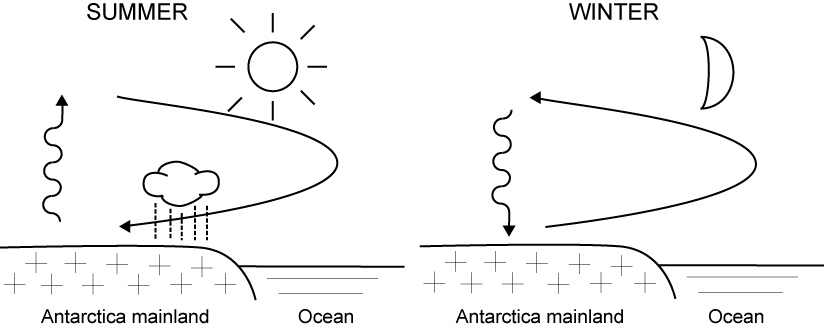始新世南极气候的研究取得重要进展
发布时间:2012-09-10
来源:古生态组
古生态组詹克平(Frédéric M.B. Jacques)副研究员与中科院南京地质古生物所合作,重建了早-中始新世南极植物化石群的古气候,首次发现早-中始新世南极夏季季风的存在。这些珍贵的研究材料是上世纪九十年代,中科院南京地质古生物所李浩敏研究员参加南极科考时采自乔治王岛的植物化石。
通过最新的气候-叶片多变量分析数据库对该植物群进行了古气候重建,表明南极在早-中始新世属于温暖、湿润的温带气候,温度和降雨量均体现出明显的季节性变化。其中夏季日降雨量为6.4±1.30毫米,占到全年总降雨量的60.3±8.28%。这种降雨量分布模式完全符合现代气候中的夏季季风类型,推测季风气候可能是由于当时陆地和海洋的气压差产生的。该研究对现有模型模拟地质时期高纬度气候的可靠性提出了挑战。
这项研究发表在国际地学类顶尖级刊物GONDWANA RESEARCH(IF 6.659,3/170 in GEOSCIENCES, MULTIDISCIPLINARY)。 文章的全文链接:http://dx.doi.org/10.1016/j.gr.2012.08.007

Fig. 1 Schematic view of the seasonal air pressure reversal over Antarctica during the
Eocene. Arrows represent the movement of air masses. In summer (left), long insulation
and low albedo result in an overheating of the continent compared to the ocean.
The low continental pressure induces winds bringing humidity from the ocean. In winter
(right), the absence of light induces a rapid cooling of the continent compared to
the ocean. The high pressure over the continent is responsible of winds towards the
ocean preventing humidity to come on the continent.
本文作者:
责任编辑:苏涛_151c53
附件:













